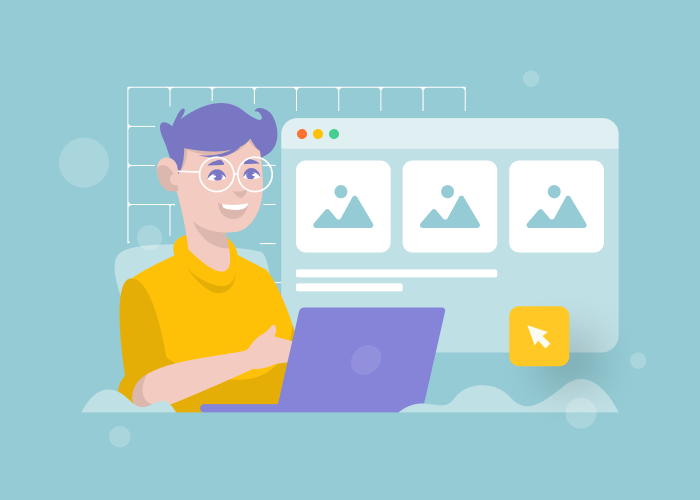Content
Enterprise Software Development. What Is Better: Custom Enterprise Solutions or Third-Party Ones?

Time to read: 20 minutes
The software industry is rapidly growing. With advances in technology at breakneck speed, it's becoming difficult to keep up with every trend. On the other hand, some technologies have managed to keep their place over the years.
But thanks to the consistent development and integration of new technologies, the enterprise software market has gained recognition worldwide.
As a business grows, it becomes difficult to manage it manually. This condition requires the use of corporate software. Enterprise software helps automate processes and caters to the entire organization’s needs with its many features. Over the years, it has gained immense popularity in several market sectors. This article discusses how enterprise software development has benefited companies and plays a different role than any conventional software.
What Is Enterprise Software and How Does It Differ from Standard Software?
Enterprise software, or enterprise application software (EAS), is computer software used to meet the needs of an organization, not individual users. These include businesses, schools, interest groups, charities, and governments. Enterprise software is an integral part of the (computer) information system; a set of such software is called an enterprise system. These systems process a subset of the organization's operations to improve business and management reporting objectives. These systems must process information relatively quickly and deploy across various networks.
According to Martin Fowler (an international public speaker on software development), enterprise applications enable the display, manipulation, and storage of large amounts of often complex data and the support or automation of business processes with that data.
Let's take a quick look at the main points in the video again:
Enterprise software vs standard software
How does enterprise software differ from standard software?
.png)
1. Different types of users. Enterprise software is used to meet the needs of an organization or enterprise, not individual users. This usually requires an interdisciplinary approach, which means that the software must be designed for users in many business functions of an organization. Building customized software for an enterprise organization allows you to adjust the software according to your unique business needs.
2. Ownership. Unlike standard software, enterprise software has a sole organizational owner, and it is not available to third-party users. The in-house developers or external support team can make any changes that are needed.
3. Opportunities. Due to limited customizability, standard software may not offer all the features your organization is looking for or needs. However, enterprise software will meet all the organization’s functional requirements.
4. Requirements. Enterprise software development is designed to meet the specific needs of an organization. When developing this type of software solution, programmers must consider engineering requirements—including localization, hardware, interoperability, scalability, and security—at the beginning of the development cycle.
Lets talk about itHave a project in mind?
Enterprise Software Market Overview
In 2022, IT spending on enterprise software is expected to amount to around 670 billion US dollars worldwide, representing 11% growth from the previous year. Like nearly all sub-segments of the IT services industry, the enterprise software market has experienced high levels of growth in recent years, with market revenues more than doubling in the decade between 2009 and 2019.
According to analysts, the growth of the global enterprise software market is due to the fact that companies are actively investing in their digital resilience to cope with the negative impact of the COVID-19 pandemic. In addition, the deteriorating economy has spurred organizations to transform their businesses digitally.
According to analysts, global spending on software for collaboration, employee communication, and the organization of corporate social networks reached $4.4 billion by the end of 2021. In 2022, 14% growth of the segment is expected, to $5.1 billion.
Gartner predicts that 65% of enterprise software will include some form of collaboration functionality by 2025. Manufacturers themselves contribute to the development of this trend. For example, Microsoft decided to embed the corporate messenger Teams into the Dynamics 365 product suite. Likewise, Salesforce plans to deeply integrate the technology of an acquired company, Slack (one of the leaders in the market for collaboration services), with its products.
The Biggest Enterprise Challenges to Anticipate and Overcome
We live in a time when business is developing rapidly, and the primary goal of any business is to achieve consistent, sustainable growth. Conquering new heights opens up even more opportunities and ways for enterprises to take the company to the next level. But it’s also essential to be prepared for obstacles that may arise on the path to long-term success. Here are the top four issues enterprises could face:
Scalability
The pandemic forced companies to reconsider all insufficiently flexible processes and systems because, in a rapidly changing market environment, the flexibility of business process management is vital.
For example, supply chain management was one of the first areas affected by the pandemic. In addition, in response to changing market demands, most organizations have been forced to expand their supply chain capabilities.
Today's supply chains require closer collaboration through cross-functional planning, advanced supply risk assessments, real-time analytics for supply monitoring, and more. Only companies with flexible systems will stay competitive and continue to grow.
Data evaluation
To keep pace with changing market trends, companies need to take a data-driven approach. Data volumes are constantly growing, and this begs a natural question: How do we add value to businesses with the help of corporate data? Unfortunately, research shows that 69% of businesses report failure to create a data-driven organization.
Another challenge is providing quick access to all corporate data within an organization. It is essential to create a single source for corporate leadership and other teams to receive real-time information about all the organization’s processes.
Integrations
Today there is a significant increase in the volume of software used by organizations, mainly medium and large enterprises. For example, according to the latest data, large companies’ total number of software applications has increased by 68%. As a result, businesses must manage a complex IT infrastructure, including third-party enterprise tools, or develop a custom enterprise software solution that must be deployed both in the cloud and on-premises.
The hardest part of this is the customized integration of all systems because they have different data models, business logic, and processes. However, integrating all corporate systems is critical to ensure the smooth operation of software components in the corporate IT environment.
On the other hand, integration leads to increased IT costs because it takes a long time to set up and connect applications to complex infrastructure.
The challenge of selecting enterprise software
Choosing software for automation and perfect enterprise processes is a rather complex and challenging task even for a small business, to say nothing of large corporations, where the amount of information and the number of people involved are many times greater. And the difficulty is not only in choosing software but also that the results of your company's work depend on this decision.
Choosing software can be described as a process that consists of three steps:
-
Selection planning
-
Selection preparation
-
Making a choice
All resources are planned during the first step, a project team is formed, and roles are assigned.
In the second step, goals are formed, implementation goals and software requests are initiated, comparison aspects are developed, and the software class is oriented.
During the third step, the company has already decided its fundamental needs and demands, and it is time to learn the functions of the software, conduct software testing, and implement secure financing.
The most significant factors when choosing corporate software are
- User interface (is it pleasing to the eye, how easy is it to view the software, and what features distinguish it from other software).
- Data management (the software must enable access to and transfer of information as well as the grouping, unification, administration, and summarization of data).
- Planning (during this stage a work breakdown structure is created, and time schedules, estimates, resource allocation schedules, and budgets are developed).
- Ensuring collaboration (as a future user, you must consider all the most important qualities and disadvantages in the software’s capabilities).
Only when the selected product meets all these requirements in full can the choice be considered successful.
Consider reading: Shopware Enterprise - the Ins and Outs of the New Offer
Why Opt for Custom Enterprise Software Instead of Third-Party Tools?
Any enterprise, regardless of size, is faced with the need to digitalize its workflow and use corporate applications, customer relationship management (CRM), or enterprise resource planning (ERP) packages. With the adoption of digital technologies, workflows become more streamlined, faster, and more efficient, saving time and avoiding the paperwork.
Although the market is now overflowing with many ready-made solutions for corporations, unfortunately, they do not always meet business needs. Thus, there is a need to develop your corporate software. Each of these approaches has pros and cons, so let’s discuss which option is best for you.
Pros and cons of custom enterprise software
What are the advantages and disadvantages of developing a customized corporate solution for your business?
Custom enterprise software pros:
- Individuality. All applications easily adapt to business processes, and not vice versa. Special software is convenient in design, so employees will quickly get used to it.
- Competitiveness. Your direct competitors will most likely use the same software, unless yours is custom. With it, you decide how your software looks and functions. Thus, you can be more successful in the market. For example, you can make your software more customer-centric while your competitors are using off-the-shelf software with limitations.
- Flexibility. You decide what you need to change in your software and when. Dedicated software provides controls for adding, modifying, and deleting features as well as adapting to new business needs.
Custom enterprise software cons:
- High price. You will need to pay the software development costs in full. Depending on your needs, the price can range from moderate to very high. The starting price will be higher than any monthly subscription. Faced with this, businesses often pursue this challenge incrementally. At first, they develop only the essential features. But remember that in this case, you will most likely save not now but in the long run. To test this, you should compare the cost of custom software with the subscription price for the duration you plan to use it.
- Duration of implementation. Custom software takes time and effort. First, you must develop a project and outline the desired functions, budget, and timeline. The planning phase usually takes a whole week. Next comes the development and implementation. The timeline for this varies, but on average, it takes three months or longer. To make a more accurate assessment, you need to consider all the features and tasks of the project.
Pros and cons of ready-made enterprise software
But what about a ready-made solution? What are the pain points when using a finished product, and how can it help your business?
Ready-made enterprise software pros:
- Availability. The cost of using existing software is several times lower than that of custom-made software. Plus, there are flexible pricing packages and free trial periods. Usually, you only pay for the space or the number of accounts you use.
- Community. Large communities using ready-made software often share blogs, articles, and videos with hacks and systems for more efficient use.
- Multifunctionality. Typically, developers try to meet the needs of most users. This means that you will most likely find the features you want. Of course, you won't be using all of them, but you will use many to get started.
Lets talk about itHave a project in mind?
Ready-made enterprise software cons:
- Compromise. Whatever the features, they will not fully suit your needs. Thus, your company will need to adapt or change its workflows for off-the-shelf software.
- Inconsistency. You will be affected by software changes. Updates aren't always for the best; sometimes functions you need are removed or changed, and you have to look for a new solution. In addition, if a software company is experiencing financial difficulties, it may close the application. Under less critical conditions, there may be temporary application crashes as bug fixes and new versions are rolled out, and you will have to wait for normal functionality to be restored.
- Preparation. Standard software often includes many functions and tools that will not be convenient for your needs. Moreover, the user, in this case, will be generalized. Therefore, if possible, be prepared to spend time setting up and learning how to use the off-the-shelf software properly. Usually, one trained person prepares the guide and then instructs others.
Of course, the software choice depends on your business goals. When choosing between a turnkey solution or custom enterprise software, start with a set of features that your business will need. If you require specific functionality, then you can, of course, get by with a ready-made solution. However, individual development is better for you if your company needs software with a complex logical chain, broad capabilities, and add-ons.
If you are at a loss with the choice of software, you can always contact our consultants, and they will be happy to help you and answer all your questions.
You may also be interested in: How to Choose the Right Enterprise E-commerce Platform.
What Dinarys Can Build for Your Enterprise
The Dinarys team knows the importance of workflow optimization like no other. With many years of experience in software development and e-commerce stores and marketplaces, we know exactly what our customers need. In the case of enterprise software, we know that businesses need flexibility, performance, and easy customization, and we are ready to offer them! We can create the following types of corporate software for you:
Customer Relationship Management (CRM)
CRM is a simple business management software. By automating all processes, CRM effectively builds a dialogue with customers, avoiding mistakes, which leads to enhanced conversion and sales.
What does a CRM look like? Imagine an Excel spreadsheet with your customer base, but when you click on the customer's name, a convenient card opens, which contains the entire history of your work with that customer, from first call to purchase. Here you can listen to calls, view the purchase history, create documents according to a template, write an e-mail or SMS, or set a task. The CRM can send the client an SMS about an order’s status or remind them of a meeting. As a result, both you and the client save time, which encourages client loyalty and future purchases. Automation in your business, thanks to CRM, helps to drive sales automatically so that everything works quickly and accurately and human errors are minimized.
.png)
Thanks to CRM, managers make fewer mistakes, which means they sell more and more often. In addition, it becomes easier for business leaders to manage the company; they spend less time on control and get more resources to develop the business.
Enterprise Resource Planning (ERP)
ERP systems are designed for resource planning and acceleration of business processes. With the help of an ERP, you can reduce the negative impact of human error and optimize the functioning of a company, within which there are many departments, divisions, and employees.
.png)
Such a program becomes a kind of enterprise strategy, within which the management of certain areas is taken into account:
- Finance, such as tax and accounting record-keeping and budget planning
- Labor personnel
- Assets
- Detailed record keeping of interactions with partners and transactions with clients
An ERP is a system that guarantees use of the right software. For example, an ERP might involve automating one or more aspects of an organization's work. Moreover, not only are the various work areas optimized but also many other processes. Finally, all results are entered into a common database, which will be stored for several years.
An ERP program entails an entire range of activities. It includes actions for
- Creating a model for managing all threads.
- Installing and maintaining storage equipment.
- Connecting the right software.
- Providing a full-fledged IT department.
- Training users on all the necessary.
Lets talk about itHave a project in mind?
Business Intelligence (BI)
BI solutions are helpful for companies from most industries—such as manufacturing, finance, retail and wholesale trade, insurance, and telecommunications—in which there is a need to understand what is happening in the business. Previously, BI was implemented only by large enterprises, and today it is difficult to imagine large organizations doing without these solutions. However, more and more medium-sized and even small businesses are starting to use analytical solutions. So what is a business intelligence system for? To track the state of affairs in the company in real-time and, if necessary, promptly respond to deviations from the norm or plan. A business intelligence system can be compared to equipment for diagnosing problems with a car; even if the car drives and everything seems fine, testing all systems will show even potential problems.
.png)
This is not the whole list of what we can offer within corporate software. Depending on your business requirements, we can create any platform you need. We are ready to discuss with you any of your needs and desires.
Dinarys’ Case Studies
Having many years of experience in creating various projects for enterprises, we would like to briefly share our most outstanding ones:
Foxtrot
For Foxtrot we created a native app for a large electronics and appliance store. Their goal was to create two native solutions to help attract more customers, stimulate brand loyalty across customer segments, and boost sales.

In the long run, our team of mobile software developers and specialists has managed to implement two smoothly performing native solutions with broad retail applications that make the lives of Foxtrot customers easier. The resulting apps are well protected, fast running, intuitive solutions with convenient product categories and app sections, all the required retail tools (such as product comparisons and one-click orders), and a sturdy connection to the extensive Foxtrot retail system.
Kontakt Home
For the Kontakt Home project, we created a semi-marketplace. Kontakt Home is a European online distributor of consumer electronics and household appliances with headquarters in Baku, Azerbaijan. Their online outlet is an e-commerce website with certain marketplace elements. Their goal was to implement a new online store based on the CMS Magento 2 and integrate it with the client's existing system.
Thanks to our Dinarys team, Kontakt Home is now presented as an intuitive, high-performance online half-marketplace with complex integrations, custom design, a React-powered front end, and seamless integration with the ERP, 1C, multiple major payment systems, and more. Overall, we consider this project an outstanding contribution to revamping our client's business on the web and securing their online presence.
Let's Start Improving Your Enterprise
Enterprise software development is an iterative process. Therefore, there is no perfect method for developing such software applications. You must assess your business requirements and follow best practices that perfectly match your business needs.
But to make enterprise software work, you have to know your goals and carefully choose a reliable software partner. Dinarys, with its impressive experience, is ready to help you with this challenging task. Fill out our form, and we will contact you to discuss the project details!
Let professionals meet your challenge
Our certified specialists will find the most optimal solution for your business.



